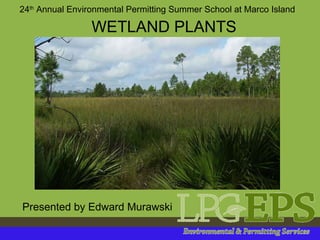
Wetland Plants: Morphology, Physiology and Functions
- 1. WETLAND PLANTS 24 th Annual Environmental Permitting Summer School at Marco Island Presented by Edward Murawski
- 3. Wetland plants are those species that normally grow within areas of standing water or where the soils are saturated within the root zone long enough for anaerobic soil conditions to develop. Wetland plants have morphological and physiological characteristics that enable them to grow in these areas. Wetland Plant Definition Wetland plants are often referred to as Hydrophytes
- 4. `` 4. Floating Growth Forms 3. Submerged 2. Floating-leaved 1. Emergent Four Main Growth Forms Phelps, 1995
- 5. Growth Forms – Emergent Emergent plants are those species rooted in saturated soils or below standing water but have their stems, leaves and reproductive parts above the water level.
- 6. `` 2. Floating-leaved Growth Forms Phelps, 1995
- 7. Growth Forms – Floating-leaved Floating-leaved plants are species that root in the soil and have leaves that float on the surface of the water .
- 8. `` Growth Forms 3. Submerged Phelps, 1995
- 9. Growth Forms – Submerged Submerged plants are rooted in the soils and have their stems and leaves under water. Flowers and other reproductive parts are found both above and below the water column.
- 10. Growth Forms - Floating Floating plants are species that do not root in the soil. These species float on the water column.
- 11. Bryophytes – Mosses Wetland plants are represented by all major plant groups. Pteridophytes – Ferns and Allies Gymnosperms – Cypress and Conifers Angiosperms – Flowering plants Representative Plant Groups
- 12. Bryophytes – Mosses Herbaceous Species Representative Plant Groups sphagnum moss ( Sphagnum spp. )
- 13. Pteridophytes – Ferns and Allies Herbaceous species netted chain fern ( Woodwardia areolata ) Virginia chain fern ( Woodwardia virginiana ), royal fern ( Osmunda regalis ) and cinnamon fern ( Osumunda cinnamomea ) Representative Plant Groups
- 14. Gymnosperms – Cypress and Conifers Woody Trees bald cypress ( Taxodium distichum ) pond pine ( Pinus serotina ) Representative Plant Groups
- 15. Angiosperms – Flowering plants Herbaceous and Woody Species (herbs, shrubs and trees) duck potato ( Sagitaria spp. ) loblolly bay tree ( Gordonia lasianthus ) blue flag iris ( Iris hexagona ) Representative Plant Groups
- 16. Wetland Plant Morphology and Physiology The wetland environment subjects wetland plants to conditions that upland plants do not have the tools to cope with. The most critical condition is anaerobic soil conditions (low oxygen levels).